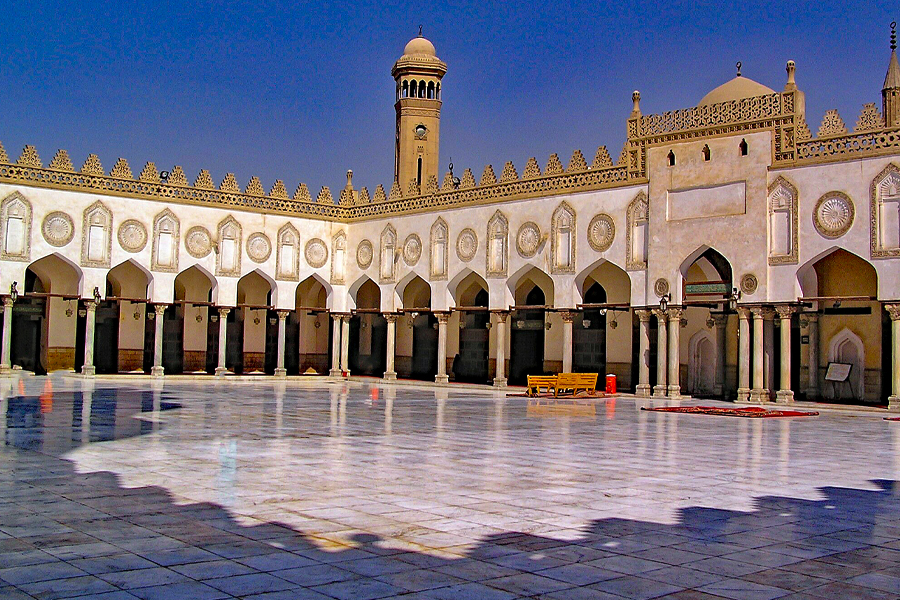During the Fatimid dynasty, the Al-Azhar Mosque was built as Cairo’s first place of worship. People come from all over the world to study there because it is the oldest and biggest Islamic university.
Cairo’s Al-Azhar is a beautiful mosque. Because it was built more than a thousand years ago, it is also called the city’s first university. People can stop by the mosque on their way to or from the Egyptian Museum at the Khan el-Khalili market in Cairo. By the end of the eleventh century, the weekly Jumma prayers were held there instead of in the older mosque.
Al Mui’z le Din Allah, the Fatimid caliph, asked Gawhar El Sekelli, a famous Fatimid army commander and the person who built Cairo, to construct the beautiful Al-Azhar Mosque, which is as old as Cairo itself. Al-Azhar can be seen on most trips to Egypt or day trips from the airport to Cairo. Its building began in 970 AD and was done in about three years.
How Al-Azhar Mosque was built:
The old building was on half of the land where Al-Azhar is now. Over the years, many caliphs, kings, sultans, and presidents of Egypt added to, rebuilt, and fixed up the mosque until it reached its current size and shape. Three prayer rooms called iwans were built around an open area called the Sahn in the first Al-Azhar Mosque.
The mosque’s entrance was on the west side, where a single Fatimid-style minaret stood guard. This section is decorated with Kofi Islamic calligraphy and flower designs, and it is the only part of the old mosque still there.
But “Abd ar-Rahman bin Katkhuda,” who liked to build a lot, did the most impressive work on the Al-Azhar Mosque in 1167 AH, 1753 CE. A new prayer room was added to the qibla corridor, separated from the other rooms by stone pillars. It has three mihrabs and three steps.
A big door was put in on the northwest side, which now faces Al-Azhar Square. It is called the Muzain gate and has two entrances. Also, a new entry called the Gate of As-Said, and a minaret was built next to it. They are both still used today. Al-Hallways. Azhar’s
The Fatimids built the Al-Azhar Mosque.
Prince “Izz al-Din Aidar was the first to look after Al-Azhar, and he fixed the broken things when the Ayyubids were in charge. It is said that the Fatimid Caliph, who kept God’s religion alive in Islamic Cairo, gave Al-Azhar its first architecture by making the entrances bigger. After falling into ruin for a long time, it was brought back to life.
On November 19, 1266 (the 18th rabi’ al-awwal of the Islamic calendar, or November 19 of the Gregorian calendar), the people who lived there said the Friday prayer in the same building that visitors to Cairo’s Museum of Islamic Art can see today. Al Amer be’ahkam Allah, king of the Fatimids, built a mihrab in 1125 A.D. A niche that shows the direction of the qibla is called a mihrab.
Islamic university of Al-Azhar:
Sultan Qaitbay Al-Mahmudi of the Circassian Mamluks (873 AH = 1468 AD) took down the door on the northwest side of the mosque, rebuilt it as it is today, and built a beautiful minaret to the right of it. This was another step in the mosque’s architectural growth. Then, Sultan Kansukh al-Ghuri built a double-headed tower, the tallest of Al-minarets Azhar’s and unique even in the Islamic world.
Al-Nasser Muhammad ibn Qalawun was in charge of the country when Baibars Khazendar, head of the army, ordered the new Tabrisi Madrasah religious school. It is to the right of the main door to the Al-Azhar Mosque. This gave the mosque, which had a lot of people who studied Islam, and an extensive Islamic library, more space.
Around 1340, the Afgaveya Madrasah was built to the left of the main entrance, where the Al-Azhar library is now located.
Al-Azhar was one of the best places to learn when the Ottomans ruled.
Al-Azhar grew a lot during the time of the Ottoman Empire. In 1753 CE, the most significant and vital building was finished by Amir Abdul Rahman Katkhuda. Behind the mihrab, he built a railway (portico) that was better than the rest of the mosque, and this let him make the place where he prayed bigger.
A brand-new minbar and mihrab were also put in. Katkhuda also added an extra tower, the Sa’aid Gate, on the south wall, and the Shrub Gate, on the east side of the mosque. Katkhuda also built the beautiful Islamic-style main entrance to the mosque on the west side.
Al-Azhar can now be seen on a variety of overnight trips from Cairo. Thanks to the work of the Supreme Council of Antiquities to fix it up, the mosque will look the same as it does now. As both a mosque and a university, Al-Azhar has played an important role in Egypt’s long and eventful history, especially during the fight against French and British colonial rule.
More information:
University Al-Azhar University is the world’s largest and most well-known Islamic school and the second Islamic university in the modern world. Since the Fatimid era, Shia Islamic teaching has been replaced by Sunni education at Al-Azhar University. However, it is still one of the most essential and well-known schools in Egypt and the world.


0 Comment